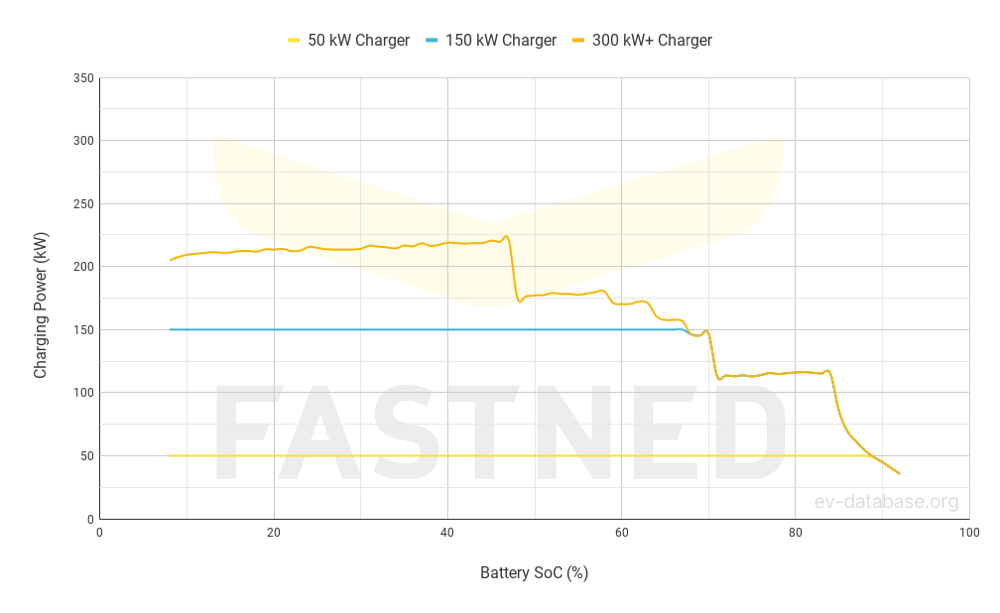Price from (last known)
£48,000
| Availability |
Not available to order |
| Available to order from |
July 2021 |
| Available to order until |
October 2021 |
| Annual VED |
£0 |
| Congestion Charge |
£0 |
| Insurance Group |
N/A |
Price shown is the last known On The Road price: it includes VAT, first year VED, vehicle first registration fee, number plates and delivery.
Real Range Estimation between 160 - 330 mi
| City - Cold Weather * |
225 mi |
| Highway - Cold Weather * |
160 mi |
| Combined - Cold Weather * |
190 mi |
| City - Mild Weather * |
330 mi |
| Highway - Mild Weather * |
205 mi |
| Combined - Mild Weather * |
255 mi |
Indication of real-world range in several situations. Cold weather: 'worst-case' based on -10°C and use of heating. Mild weather: 'best-case' based on 23°C and no use of A/C. For 'Highway' figures a constant speed of 70 mph is assumed. The actual range will depend on speed, style of driving, weather and route conditions.
Battery
| Nominal Capacity |
72.6 kWh |
| Battery Type |
Lithium-ion |
| Number of Cells |
360 |
| Architecture |
800 V |
| Warranty Period |
8 years |
| Warranty Mileage |
100,000 mi |
| Useable Capacity* |
70.0 kWh |
| Cathode Material |
No Data |
| Pack Configuration |
180s2p |
| Nominal Voltage |
653 V |
| Form Factor |
No Data |
| Name / Reference |
No Data |
Charging
Home / Destination
| Charge Port |
Type 2 |
| Port Location |
Right Side - Rear |
| Charge Power † |
11 kW AC |
| Charge Time (0->225 mi) † |
7h30m |
| Charge Speed † |
30 mph |
Rapid Charging
| Fastcharge Port |
CCS |
| FC Port Location |
Right Side - Rear |
| Fastcharge Power (max) |
221 kW DC |
| Fastcharge Power (10-80%) |
185 kW DC |
| Fastcharge Time (22->180 mi) |
17 min |
| Fastcharge Speed |
550 mph |
| Autocharge Supported |
Yes |
Plug & Charge
| Plug & Charge Supported |
No |
† This can only be achieved using a 3-phase grid connection. The majority of homes and charge points do not have this connection. In practice charge power will often be 7.4 kW, allowing for a charge time of 11h15m and a charge speed of 20 mph.
Bidirectional Charging (V2X / BPT)
Vehicle-to-Load (V2L)
| V2L Supported |
Yes |
| Max. Output Power |
3.6 kW AC |
| Exterior Outlet(s) |
1 x Type 2 (Adapter) |
| Interior Outlet(s) |
1 x UK Socket (BS1363) |
Vehicle-to-Home (V2H)
| V2H via AC Supported |
No |
| Max. Output Power |
- |
| V2H via DC Supported |
No |
| Max. Output Power |
- |
Vehicle-to-Grid (V2G)
| V2G via AC Supported |
No |
| Max. Output Power |
- |
| V2G via DC Supported |
No |
| Max. Output Power |
- |
Energy Consumption
EVDB Real Range
| Range * |
225 mi |
| Vehicle Consumption * |
311 Wh/mi |
| CO2 Emissions |
0 g/km |
| Vehicle Fuel Equivalent * |
130 mpg |
WLTP Ratings
| Range * |
267 mi |
| Rated Consumption * |
306 Wh/mi |
| Vehicle Consumption * |
262 Wh/mi |
| CO2 Emissions |
0 g/km |
| Rated Fuel Equivalent * |
132 mpg |
| Vehicle Fuel Equivalent * |
154 mpg |
Rated = official figures as published by manufacturer. Rated consumption and fuel equivalency figures include charging losses.
Vehicle = calculated battery energy consumption used by the vehicle for propulsion and on-board systems.
NOTE: The fuel equivalency figures are shown in IMPERIAL MPG. Figures in US MPG will differ significantly.
Real Energy Consumption Estimation between 212 - 438 Wh/mi
| City - Cold Weather * |
311 Wh/mi |
| Highway - Cold Weather * |
438 Wh/mi |
| Combined - Cold Weather * |
368 Wh/mi |
| City - Mild Weather * |
212 Wh/mi |
| Highway - Mild Weather * |
341 Wh/mi |
| Combined - Mild Weather * |
275 Wh/mi |
Indication of real-world energy use in several situations. Cold weather: 'worst-case' based on -10°C and use of heating. Mild weather: 'best-case' based on 23°C and no use of A/C. For 'Highway' figures a constant speed of 70 mph is assumed. The energy use will depend on speed, style of driving, climate and route conditions.
Safety (Euro NCAP)
| Safety Rating |
|
| Adult Occupant |
88% |
| Child Occupant |
86% |
| Rating Year |
2021 |
| Vulnerable Road Users |
63% |
| Safety Assist |
88% |
For more details on the safety rating of this vehicle, visit
euroncap.com
Dimensions and Weight
| Length |
4635 mm |
| Width |
1890 mm |
| Width with mirrors |
2152 mm |
| Height |
1605 mm |
| Wheelbase |
3000 mm |
| Weight Unladen (EU) |
2095 kg |
| Gross Vehicle Weight (GVWR) |
2540 kg |
| Max. Payload |
520 kg |
| Cargo Volume |
531 L |
| Cargo Volume Max |
1591 L |
| Cargo Volume Frunk |
24 L |
| Roof Load |
80 kg |
| Tow Hitch Possible |
Yes |
| Towing Weight Unbraked |
750 kg |
| Towing Weight Braked |
1600 kg |
| Vertical Load Max |
100 kg |
Miscellaneous
| Seats |
5 people |
| Isofix |
Yes, 2 seats |
| Turning Circle |
12 m |
| Platform |
HMG E-GMP |
| EV Dedicated Platform |
Yes |
| Car Body |
SUV |
| Segment |
Large Family Car |
| Roof Rails |
No |
| Heat pump (HP) |
Yes |
| HP Standard Equipment |
Yes |
Company Car Tax Indication
Financial Year 2021-22
| BIK Tax Rate |
1% |
| P11D Value from |
£47,945 |
| Benefit in Kind (BIK) |
£479 |
| BIK @ 20% |
£8 pcm |
| BIK @ 40% |
£16 pcm |
| BIK @ 45% |
£18 pcm |
Financial Year 2022-23
| BIK Tax Rate |
2% |
| P11D Value from |
£47,945 |
| Benefit in Kind (BIK) |
£959 |
| BIK @ 20% |
£16 pcm |
| BIK @ 40% |
£32 pcm |
| BIK @ 45% |
£36 pcm |
Financial Year 2023-24
| BIK Tax Rate |
2% |
| P11D Value from |
£47,945 |
| Benefit in Kind (BIK) |
£959 |
| BIK @ 20% |
£16 pcm |
| BIK @ 40% |
£32 pcm |
| BIK @ 45% |
£36 pcm |
* = estimated value. Average energy consumption and range based on moderate drive style and climate. Real-life values may differ significantly. Pricing information might not be actual for some regions. No rights can be derived from the information on this site.



